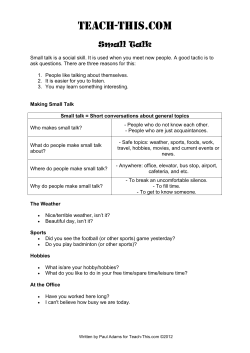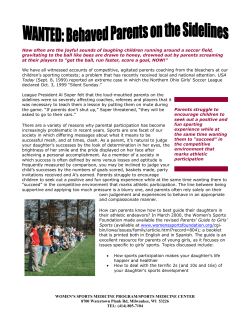
The Clegg hammer - What is it
The Clegg hammer - What is it and how is it used? Presented by Keith McAuliffe Sports Turf Institute keithm.sti@gmail.com Sports Turf Institute A world-class provider of sport and lifestyle turf surfaces expertise. ▪▪ What is a Clegg Impact Tester? Initially developed for engineering purposes, named after Dr Baden Clegg. Designed to measure the hardness or shock absorption properties of a surface. Records deceleration of a mass dropped from a standard height Readings in CIV units, 1 CIV unit = 10 gravities. Widely used in Australia and New Zealand. The Clegg hammer Hammer is dropped from set height What advantages does it offer as a performance testing tool? Quick and easy to use Reproducible Robust Correlates reasonably well with player assessment of surface hardness and ball bounce. What are the potential drawbacks with the device? Inconsistency with methodology. Different drop heights; different number of drops Weights used are much lighter than the human body so may not give readings representative of what an actual human body would achieve Where and how is the device used in Australia and NZ? Used in the sports of: Cricket Football (several codes) Golf Use in cricket – to measure pitch hardness and potential ball bounce Use of Clegg hammer in cricket Table 1. 0.5kg Clegg hammer readings taken from the Basin Reserve cricket ground (NZ) during 1991/92 season (20 readings per pitch). Match Mean value (gravities) Standard deviation Player assessment Wellington vs Otago 1990 428 137 (32%) Variable bounce NZ vs England 1991 553 93 (17%) Good bounce height; acceptable uniformity Wellington vs Canterbury 1991 438 58 (13%) Consistent bounce NZ vs England 1992 372 44 (12%) Slow & low but consistent bounce Reference to coefficient of variation is important Use in sport fields - as a safety measurement tool Several sports bodies have adopted the Clegg hammer for recording surface hardness and in turn providing a gauge of player safety. The Australian Football League (AFL) routinely tests their elite level AFL fields using the 2.25 kg Clegg Hammer. Use in community fields to indicate field condition and the need for amelioration The Sports Turf Institute routinely collects Clegg hammer data in its performance testing work. Our data base covers over 1000 sports fields from around Australia and New Zealand Analysis of this database aids understanding of limits We currently advising targeting a 1st drop readings of between 50 and 120 gravities. Example: Table 2. Trends in the mean Clegg hammer readings from all City of Sydney sports fields (data collected every 6 months). Use in elite sports fields Table 3. Clegg hammer readings (1st drop from 457mm) from Suncorp Stadium on Thursday 23rd August 2012 in relation to recommended ranges. Property Clegg hammer value Recorded value Mean historic value Recommended range Standard deviation 0.6 - - Minimum 5.0 5 4-6 Field average 6.1 6.5 6-8 Maximum 8.0 9 7-10 Example: Clegg Impact Values across Suncorp Stadium (for 1st September 2010). 100 80 60 40 20 0 10 20 30 40 50 60 Trends of 1st drop Clegg hammer readings from 2006 to 2011, Suncorp Stadium Use in golf turf The NZ Sports Turf Institute has used a Clegg hammer to gauge putting green firmness for 10 years. Some 100 golf courses have been tested; results used to form a national database. The STRI UK, have also adopted the Clegg hammer as a golf course performance testing tool. During the mid-1990s STRI measured the surface firmness of several hundred golf greens using a 0.5 kg rounded head test mass dropped from 0.5 m. Interpretation of golf green Clegg values How meaningful are the Clegg hammer readings as a gauge of surface hardness?. A 2.25kg Clegg hammer is considered by ASTM (Test number F1702) to be the standard method to measure the cushioning properties of natural turf. Usefulness to record surface hardness? Usefulness to record shock absorption? Importance of the standard deviation value The coefficient of variation will help identify the uniformity of a surface, which is arguably even more important than the mean value for surface performance Thankyou Keith McAuliffe CEO, Sports Turf Institute (Aust) Keithm.sti@gmail.com Ph. 04 24634717
© Copyright 2025

















